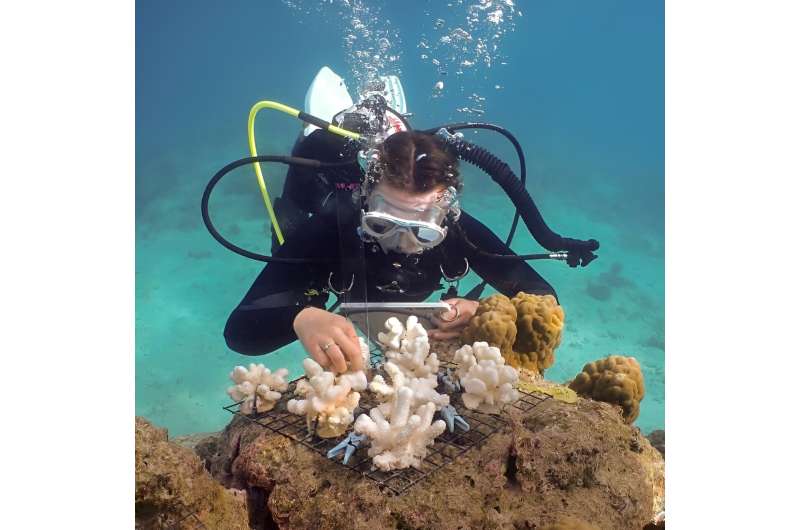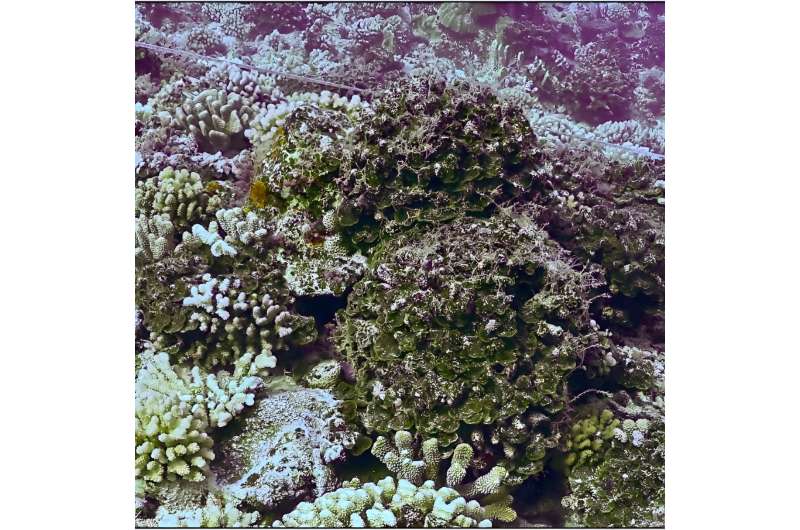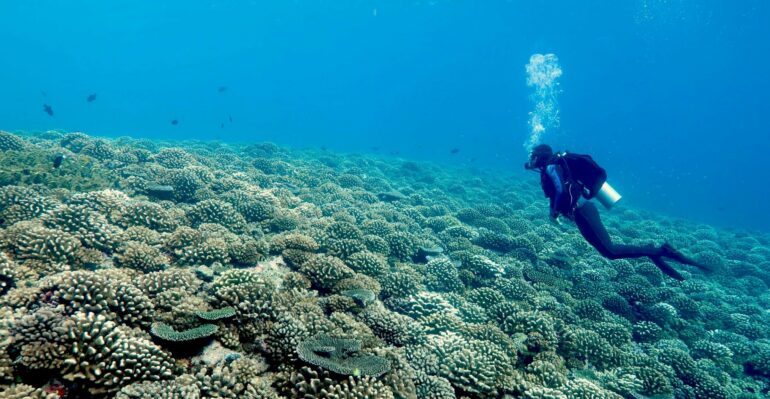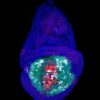The structural complexity of coral reefs creates a vibrant underwater city populated by a diverse assortment of characters. Ironically, this same complexity can impede coral recovery after disturbances.
Researchers working at reefs in Moorea, French Polynesia found that the network of dead coral skeletons left in place by bleaching events caused critical processes to break down, ultimately preventing reefs from recovering. The complex landscape protects seaweed from herbivores, enabling it to quickly colonize the reef and outgrow young coral. The results appear in the journal Global Change Biology.
Coral reefs are busy ecosystems undergoing constant change. Every now and again, a larger disturbance will rock the reef, like a storm, an influx of coral predators, or a bleaching event. While all of these can deal a blow to the ecosystem, small nuances can drastically affect the reef’s recovery.
Historically, tropical storms and cyclones have been the biggest disruptors to Moorea’s reefs. “They tend to scrape all the coral off the reef and leave behind a flat surface,” said lead author Kai Kopecky, a former doctoral student in UCSB’s Department of Ecology, Evolution, and Marine Biology. But bleaching and predation are on the rise, and these events kill coral, but leave the reef’s structure intact.
Bleaching occurs when stress—usually heat—causes corals to expel the symbiotic algae that provide them with food. Coral can recover from this if conditions quickly return to their liking, but often the colony simply dies, especially in the presence of other stressors like pollution.
A cyclone walloped Moorea’s reefs in 2010. “It removed basically every single coral colony off the fore reef,” Kopecky said. “But within about five years, it recovered back to the amount of coral it had before the storm had hit.”

Co-author Emalia Partlow measures how much dead coral skeletons protected algae from grazing herbivores. © Kai Kopecky
The reef experienced a big bleaching event in 2019, a year after Kopecky began working on the island. “It basically just cooked and killed about half the corals on the reef,” he recalled. But unlike the storm, this disturbance left all the dead coral structure in place.
Kopecky and his colleagues at the Moorea Coral Reef site noticed that the reef didn’t experience the same remarkable recovery in the following years. Instead, coral continued to die, and macroalgae, commonly known as seaweed, began to proliferate. Kopecky was curious how the differences between the two events affected reef recovery processes. In 2023, he and his co-authors published a mathematical model of the system, and this new field study focuses on describing the mechanisms at work.
“This combination of time series data on long term responses of ecosystems, mathematical modeling and field experimentation greatly enriches our scientific understanding and ability to devise practical solutions,” said co-author Professor Russ Schmitt, lead principal investigator at the Moorea Coral Reef LTER site.
“The multi-decadal, site-based research focus makes the LTER network both unique and of immense value in our rapidly changing world,” said LTER co-principal investigator Professor Sally Holbrook, who is also one of the study’s authors.
“The current project was led by Kai, a Ph.D. student at the time, and involved UCSB undergraduate researchers who made important contributions in addition to those of senior ecologists. It is a prime example of how the Moorea Coral Reef project fosters and trains the next generation of environmental scientists,” Schmitt added.
Investigating the reefscape
The team prepared small patches of the reef to create a blank slate for their experiment. They then cemented a controlled number of dead coral skeletons in each patch and plugged healthy young coral into the reef in a way that each could be periodically removed and measured as they grew. They also added trays of macroalgae to compare herbivory within the bleached skeletons to consumption out in the open.

Seaweed can quickly take over a reef after a disturbance. © Kai Kopecky et al.
“We found that dead coral skeletons prevent herbivores from being able to remove macroalgae, enabling growth and preventing new corals from being able to settle and survive on the reef,” Kopecky said.
Protection by dead coral skeletons could theoretically help young coral, if new recruits settle on the reef shortly after a bleaching event. Unfortunately, corals tend to spawn only once a year, while many algae reproduce continually, giving the seaweeds the advantage in colonizing the newly available substrate.
Macroalgae compete with coral for space, light and resources. Algae grow faster than coral, so without the balancing effect of herbivory they can easily overrun a reef, preventing new corals from settling and shading out those colonies that do. Young coral recruits are particularly vulnerable to this competition, and once a reef flips from being covered by coral to algae, it can be hard to reverse the change, as the team showed in previous research.
Considering long-term shifts
The authors compared the results in their small-scale experiments to the long-term data from the site, and they’ve seen dramatically different trajectories after the different kinds of disturbances. “Coral cover shot up on the reefs after the cyclone, while macroalgae cover went down,” Kopecky said. “After the bleaching event, it was just the opposite.”
The results find context in the concept of ecological memory, which considers how past events can influence the trajectory of an ecosystem. These shifts can produce misalignments between what an ecosystem is used to and what it’s currently experiencing.
“As these disturbance regimes change, ecological memory is also changing,” Kopecky explained. Unfortunately, the ecosystem might not be as adapted to cope with the new regime, where vast stands of dead coral skeletons are left behind after a disturbance. This can alter long-standing relationships, such as those between herbivores, algae and coral.
Kopecky wants to know if removing dead skeletons from the reef could stimulate coral recovery, or at least mitigate the impacts of bleaching.
“In coral reefs this is a novel idea and strategy,” he said. “But if you look to other ecosystems—like prescribed burns in forests to remove dead wood—people have been increasingly thinking about manipulating dead stuff in ecosystems for management purposes.”
More information:
Changing disturbance regimes, material legacies, and stabilizing feedbacks: Dead coral skeletons impair key recovery processes following coral bleaching, Global Change Biology (2024).
Provided by
University of California – Santa Barbara
Citation:
Dead coral skeletons hinder reef regeneration by sheltering seaweed (2024, September 26)



